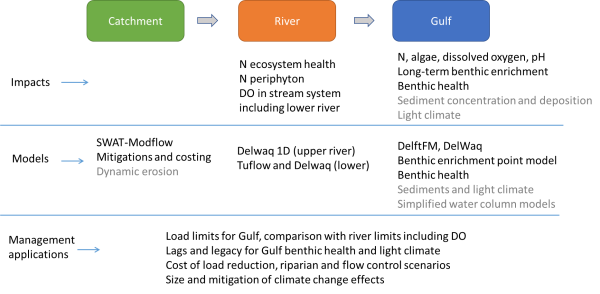The Issue
The Inner Hauraki Gulf/Tīkapa Moana ecosystem is facing proliferations of algae, de-oxygenation, reduced pH (acidification), reduced water clarity, and muddier sediments arising from historical and future land-derived contaminant inputs. These effects are likely to be exacerbated by continued inputs and climate change. Freshwater systems feeding the Gulf, such as those in the Hauraki Plains, also face stressors such as deoxygenation and excessive macrophyte growth. Regional planning initiatives have called for predictive integrative models to help identify contaminant load limits for the Hauraki Gulf land-freshwater-marine system. These models need to incorporate the effects of climate change and mitigation systems used to reduce contaminant loads.
Objectives
To address these management needs, NIWA is trialling the use of coupled land, river and marine models to predict contaminant loads and mixing, and impacts on aquatic ecosystems, and to address management questions, as depicted in the diagram below.
The approach
The modelling approach extends and couples models for land generation of contaminants, river transport and effects, and marine transport and eutrophication to address management needs. The models will use existing and new environmental datasets to test and parameterise the models. Model development and application is planned for a four-year period to 2024, although future extensions are also envisaged.
In the first year of the project, existing models were coupled and applied to scenarios of source load reduction and climate change. The models were:
WRTDS - A statistical method to calculate daily time-series of river loading from historical monthly measurements
CLUES – A catchment model of annual average nutrient generation and transport
Rating curve disaggregation – A statistical method to derive daily catchment load estimates from mean annual loads and flows, which were predicted with the hydrological model TopNet.
SWAT – A dynamic physics-based catchment model, was applied to predict changes in nutrient loading due to climate change scenario in a small dairy catchment (Toenepi)
Delwaq – A river hydraulics and contaminant transport model was coupled with SWAT in a related project.
ROMS – A sophisticated model for coastal hydrodynamics and eutrophication
A strategic plan for further modelling and associated data collection was developed in the first year of the programme, based on input from a workshop with Waikato Regional Council and Auckland Council.
Results
The results of the first year of the programme have been documented in a project report.
The pilot modelling study demonstrated the feasibility of linking catchment and coastal models to predict coastal eutrophication responses over a decadal time-scale, and using these models to assess implications of nutrient source reduction and climate change.
Some example preliminary findings are (see figure below):
- Nitrogen loading is dominated by the Waihou and Piako catchments (73% of catchment loading to the gulf), although loading per unit catchment area is more evenly spread across rivers.
- The climate change scenario indicated reductions in catchment nitrogen loading associated with runoff reductions. This is a preliminary result based on a single scenario. Since predicted river flows and loading decreased by the same magnitude, the concentrations will not change much overall.
- Catchment loading reductions required to meet river bottom-line nitrogen targets at monitoring sites were modest (16%), leading to only small reductions in algal concentrations in the Gulf. The catchment reductions are preliminary results based on simplified modelling, and depend on the selection and locations of target concentrations.
Examples of preliminary model results. a) Distribution of total nitrogen (TN) loading for each river input to the coast. b) Boxplot of the distribution of daily nitrogen loads for a dairy subcatchment for a baseline and climate change scenario. c) Spatial distribution of mean algal chlorophyll concentrations under a load reduction and a baseline scenario.
Most of the required data collection is underway or anticipated to be undertaken by Regional Councils or NIWA. NIWA is planning a survey of benthic health to inform the development of a benthic health model.
An ambitious programme for model development has been proposed to address high-priority needs (see figure below), including application in a conjunctive land-water limit-setting context.
Work plan for the 2021-24 period.
Several opportunities to expand the scope of work beyond the proposed programme have also been identified. Iwi liaison has been initiated at the ‘inform’ level, but it is anticipated that there will be deeper engagement in the future. Interactions with Regional Councils will continue, including investigation of co-funding opportunities to complete the work programme, and application of the integrated modelling approach to other catchment-estuary systems.

